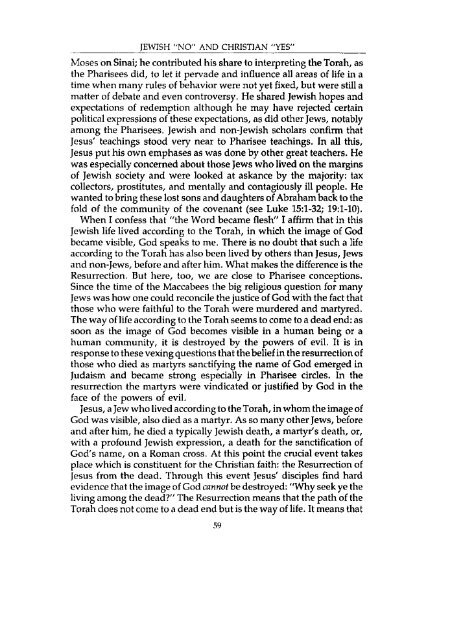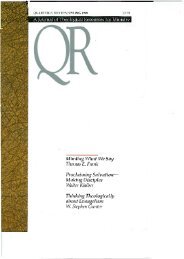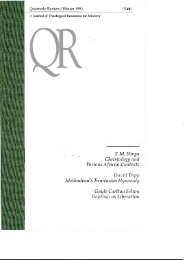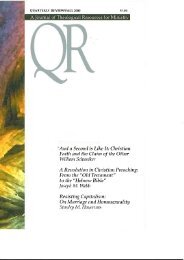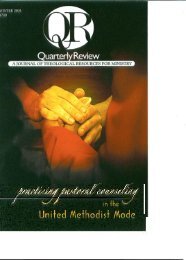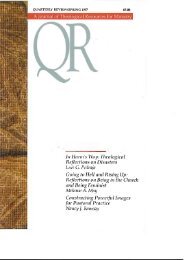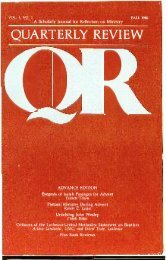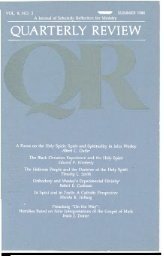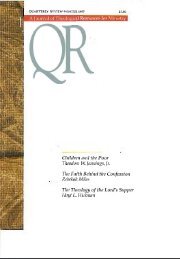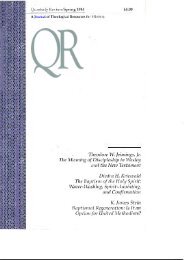Winter 1984 - 1985 - Quarterly Review
Winter 1984 - 1985 - Quarterly Review
Winter 1984 - 1985 - Quarterly Review
You also want an ePaper? Increase the reach of your titles
YUMPU automatically turns print PDFs into web optimized ePapers that Google loves.
JEWISH "NO" AND CHRISTIAN "YES"<br />
Moses on Sinai; he contributed his share to interpreting the Torah, as<br />
the Pharisees did, to let it pervade and influence all areas of life in a<br />
time when many rules of behavior were not yet fixed, but were still a<br />
matter of debate and even controversy. He shared Jewish hopes and<br />
expectations of redemption although he may have rejected certain<br />
political expressions of these expectations, as did other Jews, notably<br />
among the Pharisees. Jewish and non-Jewish scholars confirm that<br />
Jesus' teachings stood very near to Pharisee teachings. In all this,<br />
Jesus put his own emphases as was done by other great teachers. He<br />
was especially concerned about those Jews who lived on the margins<br />
of Jewish society and were looked at askance by the majority: tax<br />
collectors, prostitutes, and mentally and contagiously ill people. He<br />
wanted to bring these lost sons and daughters of Abraham back to the<br />
fold of the community of the covenant (see Luke 15:1-32; 19:1-10).<br />
When I confess that "the Word became flesh" I affirm that in this<br />
Jewish life lived according to the Torah, in which the image of God<br />
became visible, God speaks to me. There is no doubt that such a life<br />
according to the Torah has also been lived by others than Jesus, Jews<br />
and non-Jews, before and after him. What makes the difference is the<br />
Resurrection. But here, too, we are close to Pharisee conceptions.<br />
Since the time of the Maccabees the big religious question for many<br />
Jews was how one could reconcile the justice of God with the fact that<br />
those who were faithful to the Torah were murdered and martyred.<br />
The way of life according to the Torah seems to come to a dead end: as<br />
soon as the image of God becomes visible in a human being or a<br />
human community, it is destroyed by the powers of evil. It is in<br />
response to these vexing questions that the belief in the resurrection of<br />
those who died as martyrs sanctifying the name of God emerged in<br />
Judaism and became strong especially in Pharisee circles. In the<br />
resurrection the martyrs were vindicated or justified by God in the<br />
face of the powers of evil.<br />
Jesus, a Jew who lived according to the Torah, in whom the image of<br />
God was visible, also died as a martyr. As so many other Jews, before<br />
and after him, he died a typically Jewish death, a martyr's death, or,<br />
with a profound Jewish expression, a death for the sanctification of<br />
God's name, on a Roman cross. At this point the crucial event takes<br />
place which is constituent for the Christian faith: the Resurrection of<br />
Jesus from the dead. Through this event Jesus' disciples find hard<br />
evidence that the image of God cannot be destroyed: "Why seek ye the<br />
living among the dead?" The Resurrection means that the path of the<br />
Torah does not come to a dead end but is the way of life. It means that<br />
59


